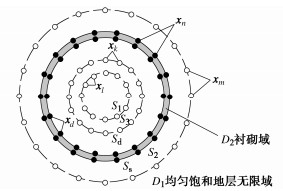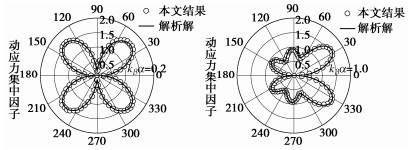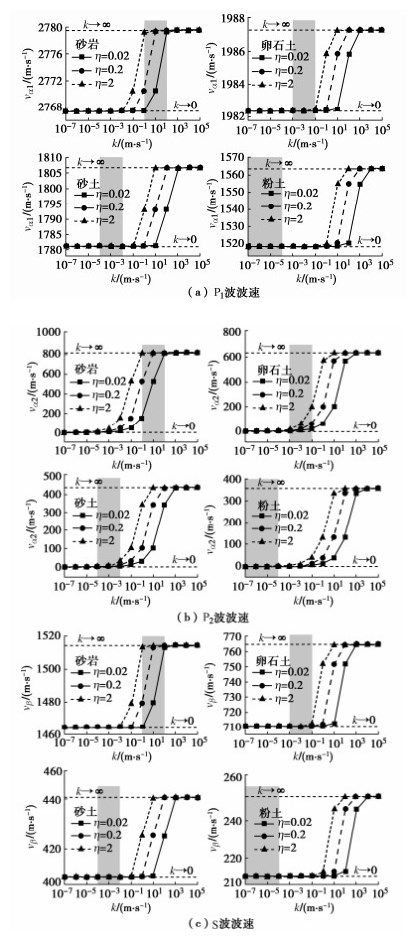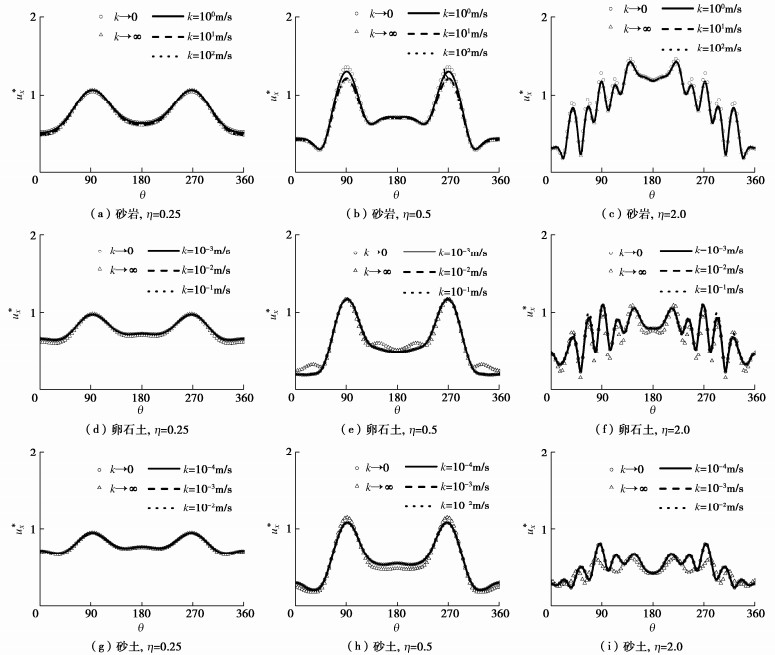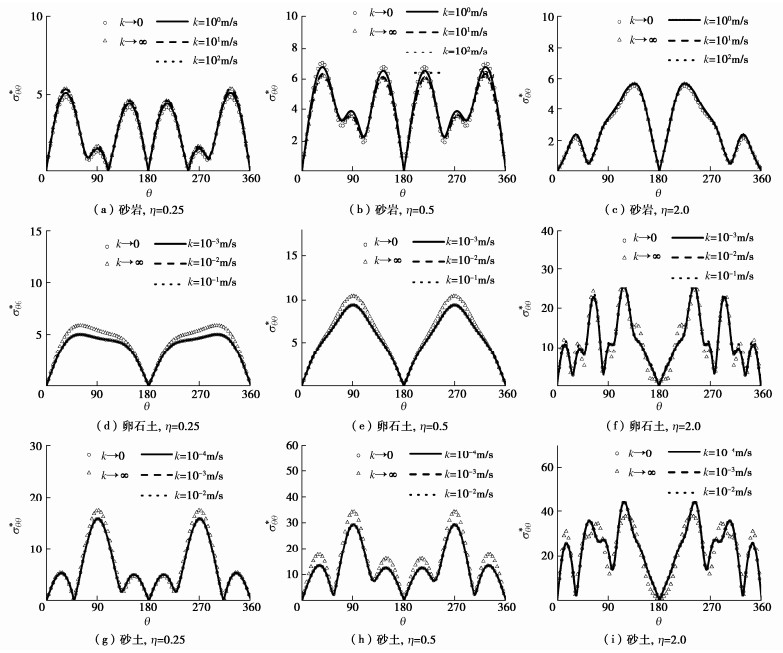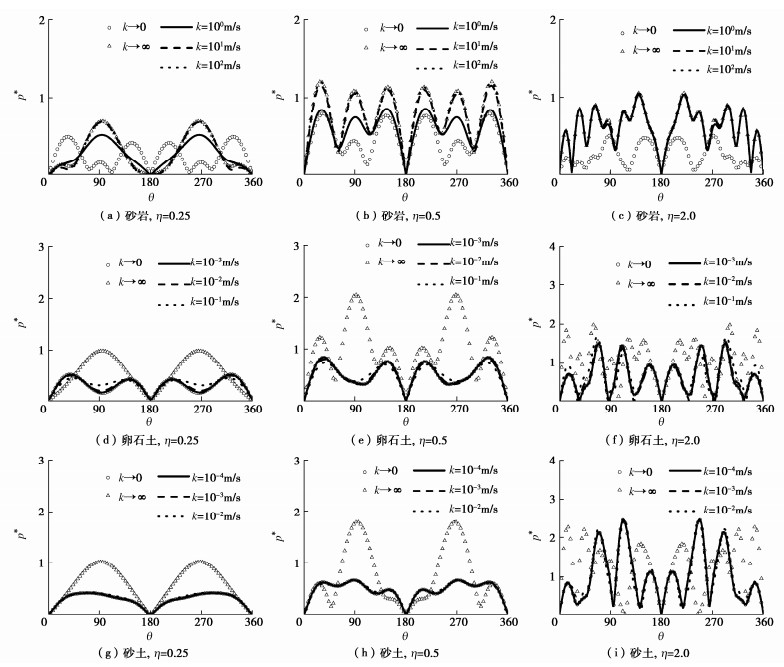Influence mechanism of permeability coefficient in homogeneously saturated strata on responses of deep tunnels under incidence of SV waves
-
摘要: 对于饱和场地中地下结构的抗震分析问题,地层渗透系数决定了孔隙水与土骨架耦合作用的强弱,是研究饱和地层–结构动力相互作用的关键参数之一。然而,目前研究通常基于渗透系数为零或无穷大的假定,忽略了实际地层的渗透特性且对其影响机制尚不清晰。针对不同类型均匀饱和地层对应的渗透系数分布范围,基于Biot两相介质理论,首先建立了饱和地层不同渗透系数情况下的u-w格式模型,推导渗透系数分别为有限值、零和无穷大3种情况下P1,P2,S波的波速解析表达式,分析了地层渗透系数变化对自由场波速的影响规律;进而,建立了不同类型饱和地层与深埋隧道动力作用分析模型,并与典型算例精确解对比验证了本模型的有效性;在此基础上,分别研究了砂岩、卵石土、砂土、粉土4种类型饱和地层渗透系数变化及两种极端值情况下隧道结构及周围地层孔隙水压力的响应机制。结果表明:对于不同类型饱和地层,3种体波在地层中的传播速度均随渗透系数k增加呈上升趋势,当k < 10-4 m/s时,波速为最小值且与k→0极端情况一致,当k > 102 m/s时,波速为最大值且与k→∞极端情况一致;对于饱和砂岩,随着渗透系数增加,隧道及地层孔压响应幅值逐渐增大且趋向于k→∞假设情况,而对于卵石土和砂土,随着渗透系数减小,隧道结构及地层孔压响应幅值逐渐增大且趋向于k→0假设情况。研究还发现,对于渗透系数在10-4~102 m/s范围内的饱和地层,隧道结构与地层响应结果相比渗透系数为两种极端值情况下的结果均相差较大,即此时计算模型不宜采用渗透系数为零或无穷大的假定。因此,实际工程抗震设计应重视饱和地层渗透系数对隧道结构及周围地层的影响。Abstract: For the seismic analysis of underground structures in saturated sites, the coupling effects of pore water and soil skeleton are determined by the permeability coefficient of strata, which is one of the key parameters in the interaction analysis between saturated strata and structures. However, the current researches are usually based on the assumption that the permeability coefficient is zero or infinite, ignoring the permeability of the actual formation, and its influence mechanism is still unclear. Based on the Biot poroelasticity theory, firstly the u-w format model is established for homogeneously saturated strata with different permeability coefficients. According to the distribution ranges of the permeability coefficients corresponding to different types of saturated strata, the analytical expressions for wave velocity of P1, P2 and S waves are derived when the permeability coefficient is finite, zero and infinite respectively, and the influences of variation of the permeability coefficient on the free-field wave velocity is analyzed. In addition, a dynamic analysis model is established for different types of saturated strata and deep tunnels, and the proposed model is verified by providing comparisons with the known solutions of typical examples. Furthermore, the response mechanisms of the tunnel structures and surrounding pore water pressures in four typical saturated strata, including sandstone, pebble soil, sandy soil and silt soil, are investigated under the scenarios of variable permeability coefficients and two extreme values (i.e., zero and infinite). The results show that the propagation velocities of three kinds of waves (P1, P2 and S waves) in different strata all increase with the permeability coefficient k. When k is less than 10-4 m/s, the wave velocity reaches the minimum and is consistent with that of the extreme value k=0. When k is greater than 102 m/s, the wave velocity reaches the maximum and is consistent with that of the extreme value k=∞. More specifically, for the saturated sandstone, the amplitudes of tunnel response and pore water pressure of strata gradually increase with the permeability coefficient and tend to the extreme case with the assumption of k=∞. While for the pebble soil and the sandy soil, the amplitudes of tunnel response and pore water pressure of strata gradually increase with the decrease of the permeability coefficient and tend to the extreme case with the assumption of k=0. What's more, for the saturated strata with permeability coefficient in the range of 10-4 m/s~102 m/s, the dynamic responses of tunnel structures and strata are quite different from those with permeability coefficient of two extreme values, which indicates the assumption that the permeability coefficient is zero or infinite cannot be used in the computational model for this situation. Therefore, the permeability coefficient of saturated strata has a significant influence on the dynamic responses of the tunnel structures and surrounding strata, and should be considered in the seismic design of practical projects.
-
-
表 1 不同类型饱和土渗透系数分布范围
Table 1 Permeability coefficients of saturated soils
饱和地层类型 静力作用下渗透系数范围k/(m·s-1) 地震作用下渗透系数范围k/(m·s-1) 岩石、堆石料等 101~10-1 1.9×102~1.9×100 级配好卵石土、砾石等 10-2~10-4 1.9×10-1~1.9×10-3 级配较好砂土等 10-3~10-5 1.9×10-2~1.9×10-4 粉土、黏质、砂细砂等 10-5~10-8 1.9×10-4~1.9×10-7 淤泥质黏土等 10-8~10-11 1.9×10-7~1.9×10-10 表 2 4类饱和地层参数及渗透系数范围
Table 2 Four types of parameters of saturated soils and range of permeability coefficient
饱和地层 剪切模量/MPa 泊松比 土颗粒体积模量/MPa 液体体积模量/MPa 土骨架平均体积模量/MPa 固体密度/(kg·m-3) 液体密度/(kg·m-3) 孔隙率 渗透系数[11] /(m·s-1) 砂岩[13] 3700 0.20 36000 2000 6166.7 2650 1000 0.300 1~102 卵石土[14] 854.7 0.17 45000 2000 1010.1 2150 1000 0.400 10-2~1 砂土[14] 277.8 0.26 30000 2000 486.1 2100 1000 0.400 10-4~10-2 粉土[14] 64.15 0.30 20000 2000 139.0 1970 1000 0.594 10-7~10-4 表 3 衬砌材料参数
Table 3 Lining material parameters
弹性模量/GPa 泊松比 密度/(kg·m-3) 32.5 0.2 2500 -
[1] 黄雨, 叶为民, 唐益群, 等. 上海深厚饱和覆盖土层的动力耦合地震反应分析[J]. 岩土力学, 2002, 23(4): 411–416. doi: 10.3969/j.issn.1000-7598.2002.04.004 HUANG Yu, YE Wei-min, TANG Yi-qun, et al. Coupled seismic response analysis of deep saturated soil covering layers in Shanghai[J]. Rock and Soil Mechanics, 2002, 23(4): 411–416. (in Chinese) doi: 10.3969/j.issn.1000-7598.2002.04.004
[2] WANG Z H, ZHAO C G, DONG L. An approximate spring-dashpot artificial boundary for transient wave analysis of fluid-saturated porous media[J]. Computers and Geotechnics, 2009, 36(1/2): 199–210.
[3] 谷音, 庄舒曼, 卓卫东, 等. 考虑饱和土的地铁车站结构非线性地震反应研究[J]. 岩土力学, 2015, 36(11): 3243–3251. https://www.cnki.com.cn/Article/CJFDTOTAL-YTLX201511028.htm GU Yin, ZHUANG Shu-man, ZHUO Wei-dong, et al. Analysis of nonlinear seismic response of subway station considering saturated soil[J]. Rock and Soil Mechanics, 2015, 36(11): 3243–3251. (in Chinese) https://www.cnki.com.cn/Article/CJFDTOTAL-YTLX201511028.htm
[4] 李亮, 吴利华, 王相宝, 等. 基于流固耦合动力模型的饱和土体-隧道体系地震反应研究[J]. 地震工程学报, 2016, 38(6): 862–868. https://www.cnki.com.cn/Article/CJFDTOTAL-ZBDZ201606003.htm LI Liang, WU Li-hua, WANG Xiang-bao, et al. Seismic response of saturated soil-tunnel system based on fluid-solid coupling dynamic model[J]. China Earthquake Engineering Journal, 2016, 38(6): 862–868. (in Chinese) https://www.cnki.com.cn/Article/CJFDTOTAL-ZBDZ201606003.htm
[5] LI P, SONG E X. A viscous-spring transmitting boundary for cylindrical wave propagation in saturated poroelastic media[J]. Soil Dynamics and Earthquake Engineering, 2014, 65: 269–283. doi: 10.1016/j.soildyn.2014.06.022
[6] LIU Z X, JU X, WU C Q, et al. Scattering of plane P1 waves and dynamic stress concentration by a lined tunnel in a fluid-saturated poroelastic half-space[J]. Tunnelling and Underground Space Technology, 2017, 67: 71–84. doi: 10.1016/j.tust.2017.04.017
[7] FETTER C W. Applied Hydrogeology[M]. Long Grove: Waveland Press, 1994.
[8] 刘中宪, 琚鑫, 梁建文. 饱和半空间中隧道衬砌对平面SV波的散射IBIEM求解[J]. 岩土工程学报, 2015, 37(9): 1599–1612. https://www.cnki.com.cn/Article/CJFDTOTAL-YTGC201509008.htm LIU Zhong-xian, JU Xin, LIANG Jian-wen. IBIEM solution to scattering of plane SV waves by tunnel lining in saturated poroelastic half-space[J]. Chinese Journal of Geotechnical Engineering, 2015, 37(9): 1599–1612. (in Chinese) https://www.cnki.com.cn/Article/CJFDTOTAL-YTGC201509008.htm
[9] HAN B, ZDRAVKOVIC L, KONTOE S. Numerical and analytical investigation of compressional wave propagation in saturated soils[J]. Computers and Geotechnics, 2016, 75: 93–102. doi: 10.1016/j.compgeo.2016.01.019
[10] BIOT M A. Mechanics of deformation and acoustic propagation in porous media[J]. Journal of Applied Physics, 1962, 33(4): 1482–1498. doi: 10.1063/1.1728759
[11] WONG H L. Diffraction of P, SV, and Rayleigh waves by surface topography[M]. California: University of California, 1979.
[12] 钟启凯. 地下圆形组合衬砌洞室在地震波下的动力反应分析[D]. 长沙: 湖南大学, 2009. ZHONG Qi-kai. Dynamic Response Aanalysis of Underground Cylindrical Composite- Lining Cavern Subjected to Seismic Waves[D]. Changsha: Hunan University, 2009. (in Chinese)
[13] LIN C H, LEE V W, TRIFUNAC M D. The reflection of plane waves in a poroelastic half-space saturated with inviscid fluid[J]. Soil Dynamics and Earthquake Engineering, 2005, 25(3): 205–223. doi: 10.1016/j.soildyn.2004.10.009
[14] 宋佳. 饱和土场地波动数值模拟方法及其工程应用[D]. 北京: 北京工业大学, 2017. SONG Jia. Wave Numerical Method of Saturated Site Soil and its Engineering Application[D]. Beijing: Beijing University of Technology, 2017. (in Chinese)
[15] HASHASH Y M A, HOOK J J, SCHMIDT B, et al. Seismic design and analysis of underground structures[J]. Tunnelling and Underground Space Technology, 2001, 16(4): 247–293. doi: 10.1016/S0886-7798(01)00051-7
[16] 李瑞山, 袁晓铭, 吴晓阳. 抗震规范等效剪切波速简化算法适用性研究[J]. 地震工程与工程振动, 2018, 38(3): 30–36. https://www.cnki.com.cn/Article/CJFDTOTAL-DGGC201803004.htm LI Rui-shan, YUAN Xiao-ming, WU Xiao-yang. Study on the applicability of simplified equivalent shear wave velocity calculation method in seismic design code[J]. Earthquake Engineering and Engineering Dynamics, 2018, 38(3): 30–36. (in Chinese) https://www.cnki.com.cn/Article/CJFDTOTAL-DGGC201803004.htm




 下载:
下载:
